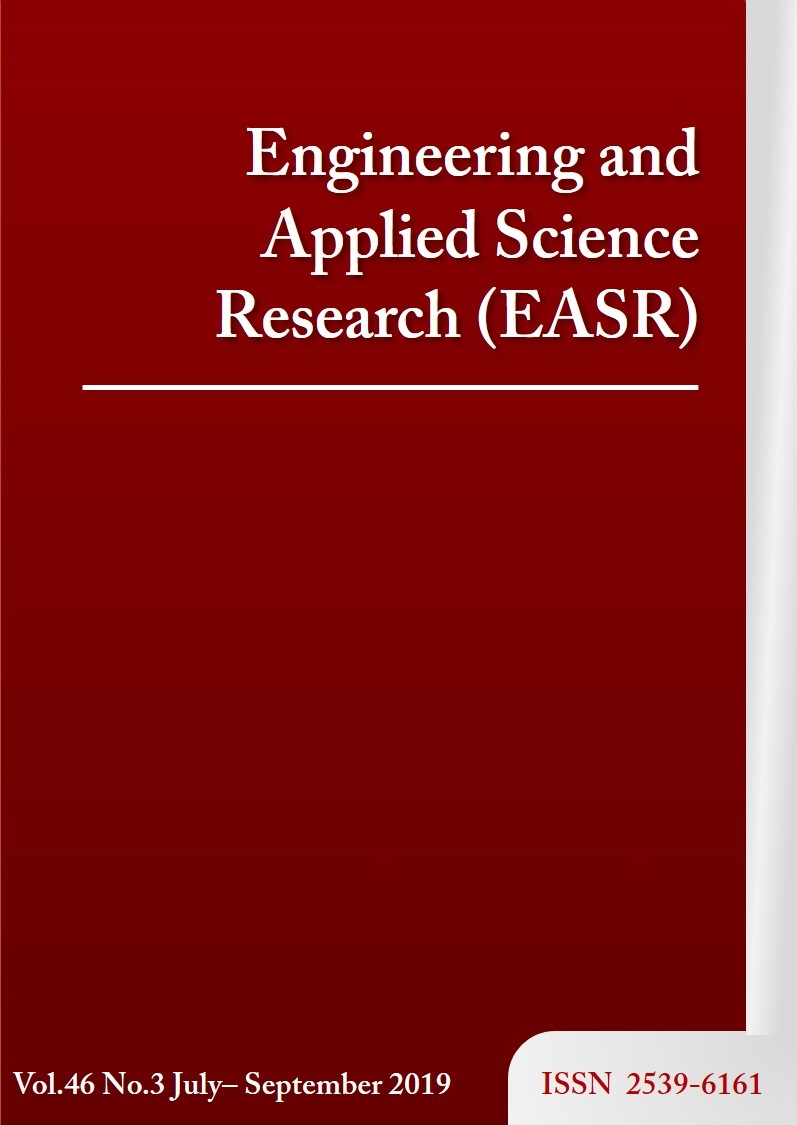Mathematical models of a fluidized bed bioreactor using granular activated carbon (FBBR-GAC) for wastewater treatment
Main Article Content
Abstract
This study aimed to develop mathematical models of a novel recirculation plug-flow reactor (RPFR) and recirculation completely-mixed stirred tank reactors (RCSTR). It was done evaluate and predict wastewater treatment performance using a fluidized bed bioreactor with granular activated carbon (FBBR-GAC). Wastewaters from household washing activities and from an industrial dairy process were used in these experiments. The highest COD removal (>90%) from the two wastewaters were achieved at recirculation ratio (R) of 936. The kinetic results showed that the rate of COD removal from the two types of wastewater used with FBBR-GAC reactors followed 2nd order kinetic models, with k2,RPFR values of 4.68 x 10-2 and 2.81 x 10‑2 mg‑1 Ld‑1for washing and dairy wastewaters, respectively. Additionally, we found that the RPFR model was more suitable for describing the behavior of the FBBR-GAC system than the RCSTR model. The developed RPFR model can precisely predict the effluent COD of wastewater at the optimum rate of recirculation (R) 936, and optimum rate of the bed's stirrer speed (NB) 25 rpm. Based on the optimum R and kinetic model, the developed RPFR model can be used to predict the COD reduction overtime. For a continuous process, an optimal flowrate can be obtained from the HRT that gives the desired COD removal at a given reactor volume.
Article Details
This work is licensed under a Creative Commons Attribution-NonCommercial-NoDerivatives 4.0 International License.
References
Ng J. Industrial wastewater treatment. London: Imperial College Press; 2006.
Boshier JA. Criteria for assessing appropriate technology for sewage treatment and disposal. Water Sci Tech. 1993;27(1):11-8.
Lansdell M. 15 Years of practical sewage treatment in Venezuela. Water Sci Tech. 1996;33(3):39-46.
Suksomboon R, Junsiri C. The performance of moving fluidized bed bioreactor-granular activated carbon, MFBBR- GAC. Prawarun Agr J. 2018;15(1):238-47.
Lohi A, Cuenca MA, Anania G, Upreti SR, Wan L. Biodegradation of diesel fuel-contaminated wastewater using a three-phase fluidized bed reactor. J Hazard Mater. 2008;154(1-3):105-11.
Patel A, Zhu J, Nakhla G. Simultaneous carbon, nitrogen and phosphorous removal from municipal wastewater in a circulating fluidized bed bioreactor. Chemosphere. 2006;65(7):1103-12.
Xing W, Ngo HH, Guo W, Wu Z, Nguyen TT, Cullum P, et al. Enhancement of the performance of anaerobic fluidized bed bioreactors (AFBBRs) by a new starch based flocculant. Separ Purif Tech. 2010;72(2):140-6.
Mowla D, Ahmadi M. Theoretical and experimental investigation of biodegradation of hydrocarbon polluted water in a three phase fluidized-bed bioreactor with PVC biofilm support. Biochem Eng J. 2007;36(2):147-56.
Saravanane R, Murthy DVS. Application of anaerobic fluidized bed reactors in wastewater treatment: a review. Environ Manag Health. 2000;11(2):97-117.
Shieh WK, Keenan JD. Fluidized bed biofilm reactor for wastewater treatment. Bioproducts: Advances in Biochemical Engineering/Biotechnology. Berlin: Springer Berlin Heidelberg; 1986. p. 131-69.
Meshko V, Markovska L, Mincheva M, Rodrigues AE. Adsorption of basic dyes on granular acivated carbon and natural zeolite. Water Res. 2001;35(14):3357-66.
Qasim SR, Motley EM, Zhu G. Water Works Engineering: Planning, Design and Operation. Upper Saddle River, NJ: Prentice Hall; 2000.
Benefield LD, Randall CW. Biological process design for wastewater treatment. USA: Prentice-Hall; 1980.
Tchobanoglous G, Burton FL, Stensel HD, Metcalf & Eddy Inc, Burton F. Wastewater engineering: treatment and reuse. 4th rev. ed. Boston: McGraw-Hill; 2003.
Tchobanoglous G, Schroeder ED. Water quality: characteristics, modeling, modification. USA: Addison-Wesley; 1985.
Vennard JK, Street RL. Elementary fluid mechanics. New York: Wiley; 1982.
Daugherty RL, Finnemore EJ, Franzini JB. Fluid mechanics with engineering applications. SI metric ed. New York: McGraw-Hill; 1989.
Reynolds TD. Solutions manual for unit operations and processes in environmental engineering. California: Brooks/Cole Engineering Division; 1982.
Boutin C, Eme C. Domestic wastewater characterization by emission source. 13eme congress spécialisé IWA on Small Water and wastewater Systems; 2016 Sep 14-16; Athènes, Greece. p.1-9.
Haribabu K, Sivasubramanian V. Treatment of wastewater in fluidized bed bioreactor using low density biosupport. Energy Procedia. 2014;50:214-21.
Haribabu K, Sivasubramanian V. Biodegradation of organic content in wastewater in fluidized bed bioreactor using low-density biosupport. Desalin Water Treat. 2016;57(10):4322-7.



